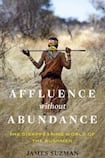
We occupy a fallen state, earning our bread by the sweat of our brows. Were it not for the sin of Adam and Eve we would live in a garden, contented and naked and free.
The doctrine of original sin is unique to Christianity, but there is a universal ache beyond it, encountered in every human society – the yearning for a long-vanished Eden.
Hunter-gatherers told themselves stories of Dream Times and First Times, when men and animals could speak the same language, assume each others’ shapes, and their primeval struggles formed mountains and deserts and seas.
The ancient Greeks – pragmatic, hard-working farmers – cherished myths of an easier, more pastoral existence, when shepherds and shepherdesses lolled on warm hillsides, enticing the Gods.
Such myths are still being shaped and recycled. In 1969, writing about the Woodstock festival, Joni Mitchell concluded: “We are star dust, billion year old carbon. We are golden, caught in a devil’s bargain. And we’ve got to get ourselves back to the garden.”
She herself had missed the festival, opting instead to appear on Dick Cavett’s TV show. She must have felt that she had blown it. Woodstock, the Agincourt of her generation, would always for her be an ache in the past, unattainable. Eden is never a place on this earth.
But what if it was? What if there really was an earthly paradise, or something quite like it: a state of innocence and sufficiency where people walked naked and free? In recent decades some anthropologists, studying the lives and economies of the aboriginal hunter-gatherers of places as diverse as Australia, southern Africa and South America, have begun to wonder if these supposedly primitive and destitute wanderers were really as wretched as “civilisation” assumed. What if they were, in human terms, better off than their first colonisers?
This thesis of "primitive affluence", dating back to the 1960s, is examined again by James Suzman in Affluence Without Abundance, a book based on his anthropological field-work with the Ju'/hoansi bushmen of eastern Namibia (the punctuation marks represent click consonants used in the Khoisan languages of southern Africa; the term "bushman", once regarded by some as pejorative, has been rehabilitated.)
Suzman cites the seminal study by the American anthropologist Richard Borshay Lee, who concluded that the Ju’/hoansi were able to make a comfortable living by working only 15 hours a week at hunting and/or gathering (which they usually found intensely enjoyable) plus another 20 hours spent on domestic chores. At that time, the average US worker spent 40 hours or more a week at work, and another 36 hours on unpaid but obligatory tasks.
Like the other scattered bushman bands of the southern African dry lands, the Ju’/hoansi, though highly intelligent, exhibited an obliviousness to linear time, an unconcern for the past and the future that would seem, to us children of the agricultural revolution, feckless and fatalistic.
But 150,000 years or more of almost unchanging existence in their native environment had taught the bushmen – thought to be ancestors of all modern human beings – that the land would usually provide enough food for them, from one source or another. There was little point in worrying about the future or clinging to the past.
Hoarding no surpluses, defending no homesteads, roaming with no more property than they could carry, the hunter-gatherers were existentially more secure than the farmers and herders who gradually supplanted them.
While the bushmen could forage and hunt for a wide range of food sources, early farmers relied on only one or two staples, and on the ability to store and guard surpluses for lean months, and seed for their next crop. In good times, their back-breaking toil allowed them to multiply much faster than hunter-gatherer bands living off the land. But when harvests failed, or neighbours raided their herds, famine and warfare ravaged the farmers.
Inevitably, a suspicion of Rousseauesque romanticism hangs over any reappraisal of the pre-agricultural state. But Dr Suzman’s honest and sharp account is no retread of the “noble savage” theory. As much personal memoir as anthropological survey, it also tells the story of the Ju’/hoansi in their present declining condition, eking out marginal lives in resettlement farms and remote shanty towns on the edge of the Kalahari.
Deprived of their traditional territories, first by the slow encroachment of Bantu agricultural peoples from further north, and then later by white colonists, most bushmen are no longer permitted to hunt. Few of the young know how to hunt anyway. And the game fences that run for hundreds of miles across the Kalahari thirstlands, erected to protect cattle herds from wild diseases, have blocked ancient migration routes, killing off most of the game.
There is, it seems, no way back to that garden. But Suzman’s talent for evoking the region’s vast and haunting landscapes, his elegiac account of a passing covenant with nature, and his warm and compassionate character sketches of individual Ju’/hoansi, make this a fascinating and at times profoundly moving work of literary non-fiction.












